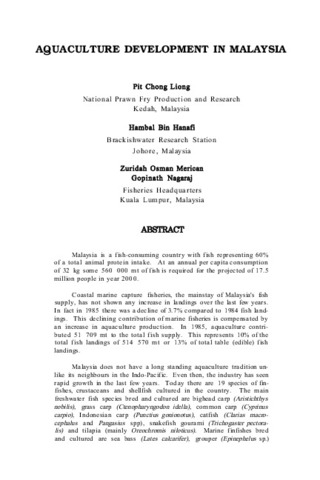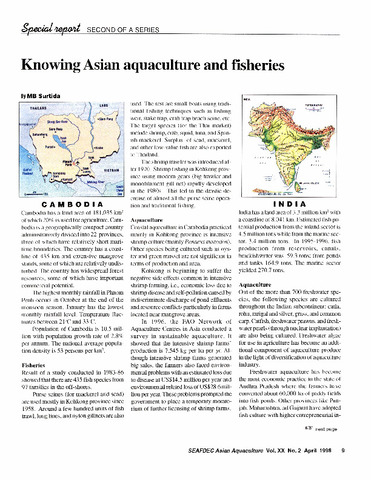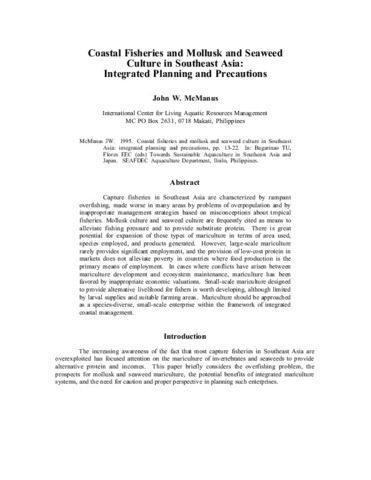Perlihatkan publikasi sederhana
Aquaculture development in Malaysia
| dc.contributor.author | Liong, Pit Chong. | |
| dc.contributor.author | Hanafi, Hambal Bin. | |
| dc.contributor.author | Merican, Zuridah Osman. | |
| dc.contributor.author | Nagaraj, Gopinath. | |
| dc.contributor.editor | Juario, Jesus V. | |
| dc.contributor.editor | Benitez, Lita V. | |
| dc.date.accessioned | 2011-06-06T02:33:59Z | |
| dc.date.available | 2011-06-06T02:33:59Z | |
| dc.date.issued | 1988 | |
| dc.identifier.citation | Liong, P. C., Hanafi, H. B., Merican, Z. O., Nagaraj, G. (1988). Aquaculture development in Malaysia. In J. V. Juario & L. V. Benitez (Eds.), Perspectives in Aquaculture Development in Southeast Asia and Japan: Contributions of the SEAFDEC Aquaculture Department. Proceedings of the Seminar on Aquaculture Development in Southeast Asia, 8-12 September 1987, Iloilo City, Philippines. (pp. 73-90). Tigbauan, Iloilo, Philippines: SEAFDEC, Aquaculture Department. | en |
| dc.identifier.isbn | 971851113X | |
| dc.identifier.uri | http://hdl.handle.net/10862/140 | |
| dc.description.abstract | Malaysia is a fish-consuming country with fish representing 60% of a total animal protein intake. At an annual per capita consumption of 32 kg some 560 000 mt of fish is required for the projected of 17.5 million people in year 2000. Coastal marine capture fisheries, the mainstay of Malaysia's fishsupply, has not shown any increase in landings over the last few years. In fact in 1985 there was a decline of 3.7% compared to 1984 fish landings. This declining contribution of marine fisheries is compensated by an increase in aquaculture production. In 1985, aquaculture contributed 51 709 mt to the total fish supply. This represents 10% of the total fish landings of 514 570 mt or 13% of total table (edible) fish landings. Malaysia does not have a long standing aquaculture tradition unlike its neighbours in the Indo-Pacific. Even then, the industry has seen rapid growth in the last few years. Today there are 19 species of finfishes, crustaceans and shellfish cultured in the country. The main freshwater fish species bred and cultured are bighead carp (Aristichthys nobilis), grass carp (Ctenopharyngodon idella), common carp (Cyprinus carpio), Indonesian carp (Punctius gonionotus), catfish (Clarias macrocephalus and Pangasius spp), snakefish gourami (Trichogaster pectoralis) and tilapia (mainly Oreochromis niloticus). Marine finfishes bred and cultured are sea bass (Lates calcarifer), grouper (Epinephelus sp.) and snapper (Lutjanus johni). Penaeus monodon is the dominant marine prawn species bred and cultured but culture of P. merguiensis is receiving considerable interest. Macrobrachium rosenbergii is the only freshwater prawn cultured commercially. Molluscs cultured are the blood clam (Anadara granosa) and the green mussel (Perna viridis). In 1985, blood clam and mussel culture accounted for 87% of all aquaculture production of Malaysia, freshwater fish 12%, floating cage culture of marine fish 0.7% and brackishwater pond culture 0.3%. In terms of value blood clam and mussels represented 30% (M$15M) of total value (M$49.5M), freshwater fish 57% (M$28M),cage culture of marine fin fishes 7% (M$3.4M),and brackishwater pond production 6% (M$2.1M). Aquaculture in Malaysia has considerable growth potential. It is projected that 22 000 ha of mangrove will be opened by the year 2000 for shrimp culture. Some 330 000 m2 of protected coastal waters have been identified for cage culture. Some 6500 rafts can considerably expand the present capacity. In freshwater culture about 8000 ha of land and 17 500 ha of mining pools can be developed while 200 000 ha of artificial lakes and impoundments for freshwater fish cage culture are available. Yet such development is not without constraints. Freshwater finfish culture is hampered by lack of good quality broodstock. There is also a limited market for freshwater finfishes. Marine finfish culture is limited by lack of fingerlings and good quality compounded diet to replace trash fish which is deteriorating in quality and quantity. Marine prawn culture is heavily dependent on wild spawners, the supply unpredictable and inadequate. Acid sulfate soil continues to cause the deterioration of brackishwater ponds. Cockles and mussels can be sold to export markets only if they meet specific quality standards. | en |
| dc.language.iso | en | en |
| dc.publisher | Aquaculture Department, Southeast Asian Fisheries Development Center | en |
| dc.subject | Ctenopharyngodon idella | en |
| dc.subject | Clarias macrocephalus | en |
| dc.subject | Penaeus monodon | en |
| dc.subject | Trichogaster pectoralis | en |
| dc.subject | Lates calcarifer | en |
| dc.subject | Perna viridis | en |
| dc.subject | Pangasius | en |
| dc.subject | Epinephelus | en |
| dc.subject | Cyprinus carpio | en |
| dc.subject | Anadara granosa | en |
| dc.subject | Macrobrachium rosenbergii | en |
| dc.subject | Oreochromis niloticus | en |
| dc.subject | Malaysia | en |
| dc.title | Aquaculture development in Malaysia | en |
| dc.type | Conference paper | en |
| dc.citation.spage | 73 | |
| dc.citation.epage | 90 | |
| dc.citation.conferenceTitle | Seminar on Aquaculture Development in Southeast Asia, 8-12 September 1987, Iloilo City, Philippines | en |
| dc.subject.asfa | marine fisheries | en |
| dc.subject.asfa | prawn culture | en |
| dc.subject.asfa | cultured organisms | en |
| dc.subject.asfa | freshwater fishes | en |
| dc.subject.asfa | aquaculture | en |
| dc.subject.asfa | marine fish | en |
| dc.subject.asfa | fish consumption | en |
| dc.subject.asfa | soil | en |
| dc.subject.asfa | fisheries | en |
| dc.subject.asfa | coastal fisheries | en |
| dc.subject.asfa | acidification | en |
| dc.subject.asfa | breeding stock | en |
| dc.subject.asfa | aquaculture techniques | en |
| dc.subject.asfa | fish culture | en |
| dc.subject.asfa | diet | en |
| dc.subject.asfa | feeding | en |
| dc.subject.asfa | shellfish culture | en |
| dc.subject.asfa | feeds | en |
| dc.subject.asfa | crustacean culture | en |
| dc.subject.asfa | mollusc culture | en |
| dc.subject.asfa | catch statistics | en |
| dc.subject.asfa | aquaculture economics | en |
| dc.subject.asfa | landing statistics | en |
| dc.subject.asfa | aquaculture enterprises | en |
| dc.subject.asfa | aquaculture development | en |
| dc.subject.asfa | fingerlings | en |
| dc.subject.asfa | cage culture | en |
| dc.subject.asfa | mariculture | en |
| dc.subject.asfa | freshwater aquaculture | en |
| dc.subject.scientificName | Penaeus monodon | en |
| dc.subject.scientificName | Hypophthalmichthys nobilis | |
| dc.subject.scientificName | Puntius gonionotus | en |
| dc.subject.scientificName | Fenneropenaeus merguiensis | en |
| dc.subject.scientificName | Lutjanus johni | en |
| dc.subject.scientificName | Lates calcarifer | en |
Files in this item
Publikasi ini ada di koleksi berikut
-
ADSEA '87 [20]
Proceedings of the Seminar on Aquaculture Development in Southeast Asia, 8-12 September 1987, Iloilo City, Philippines





